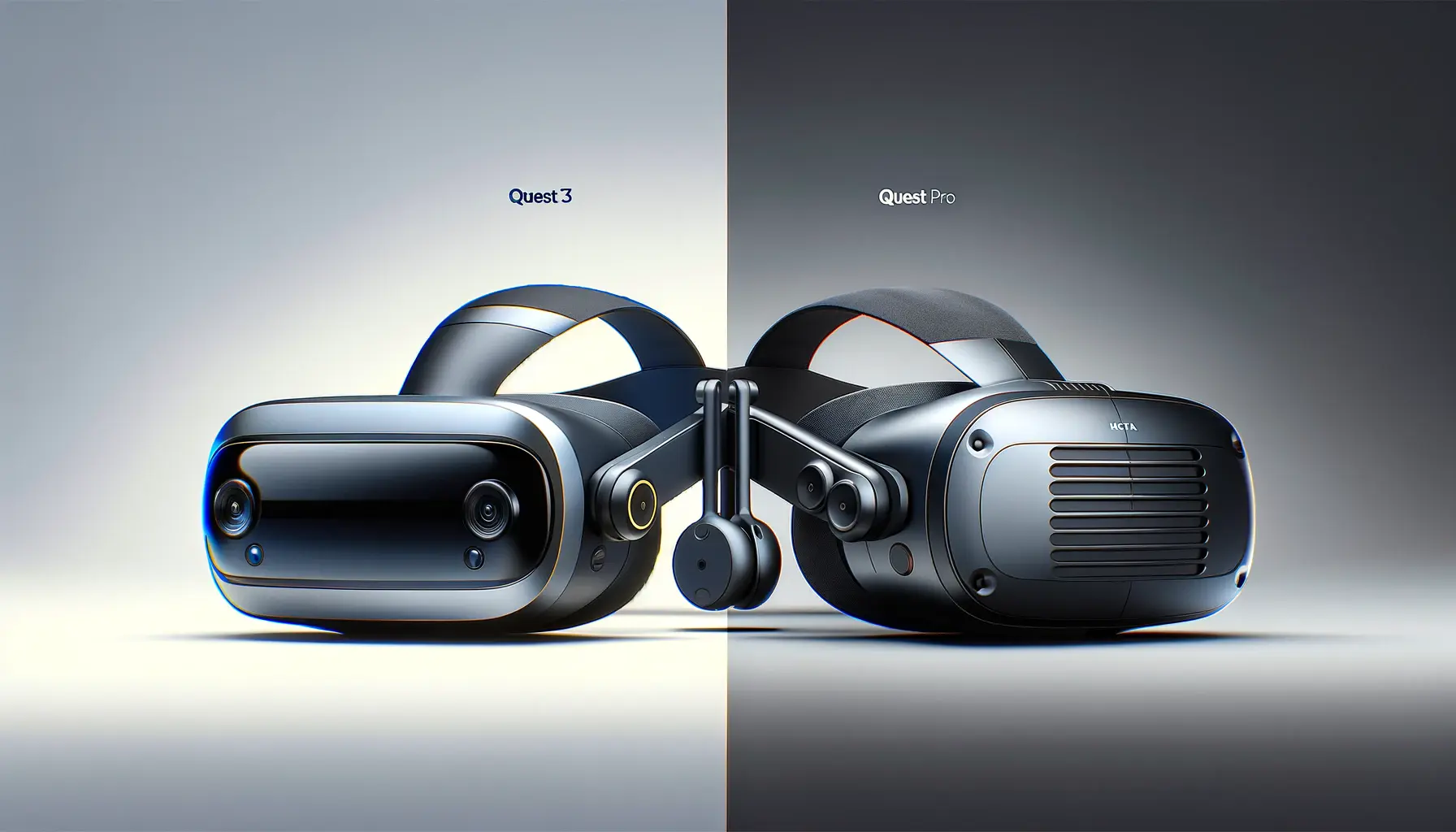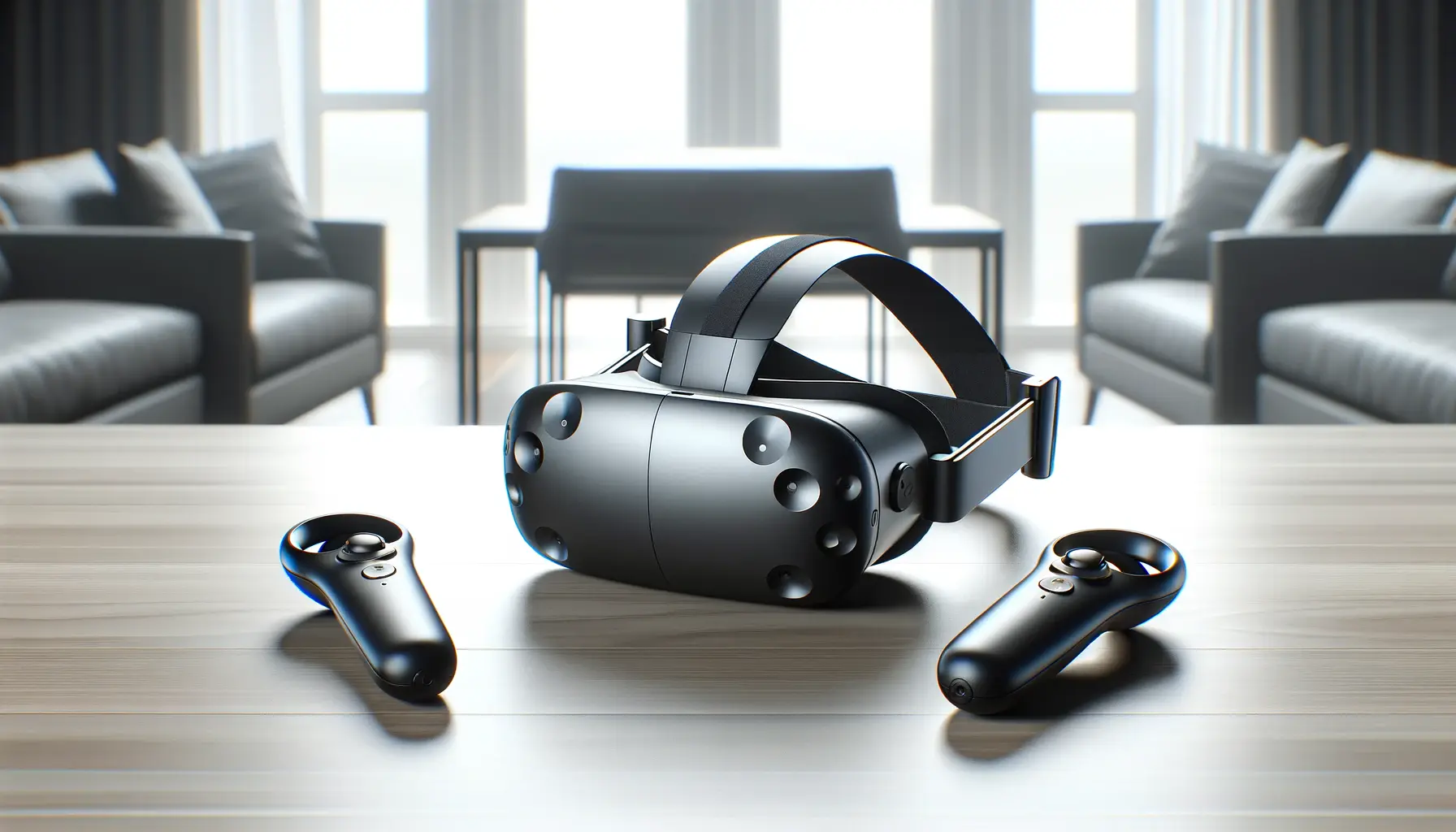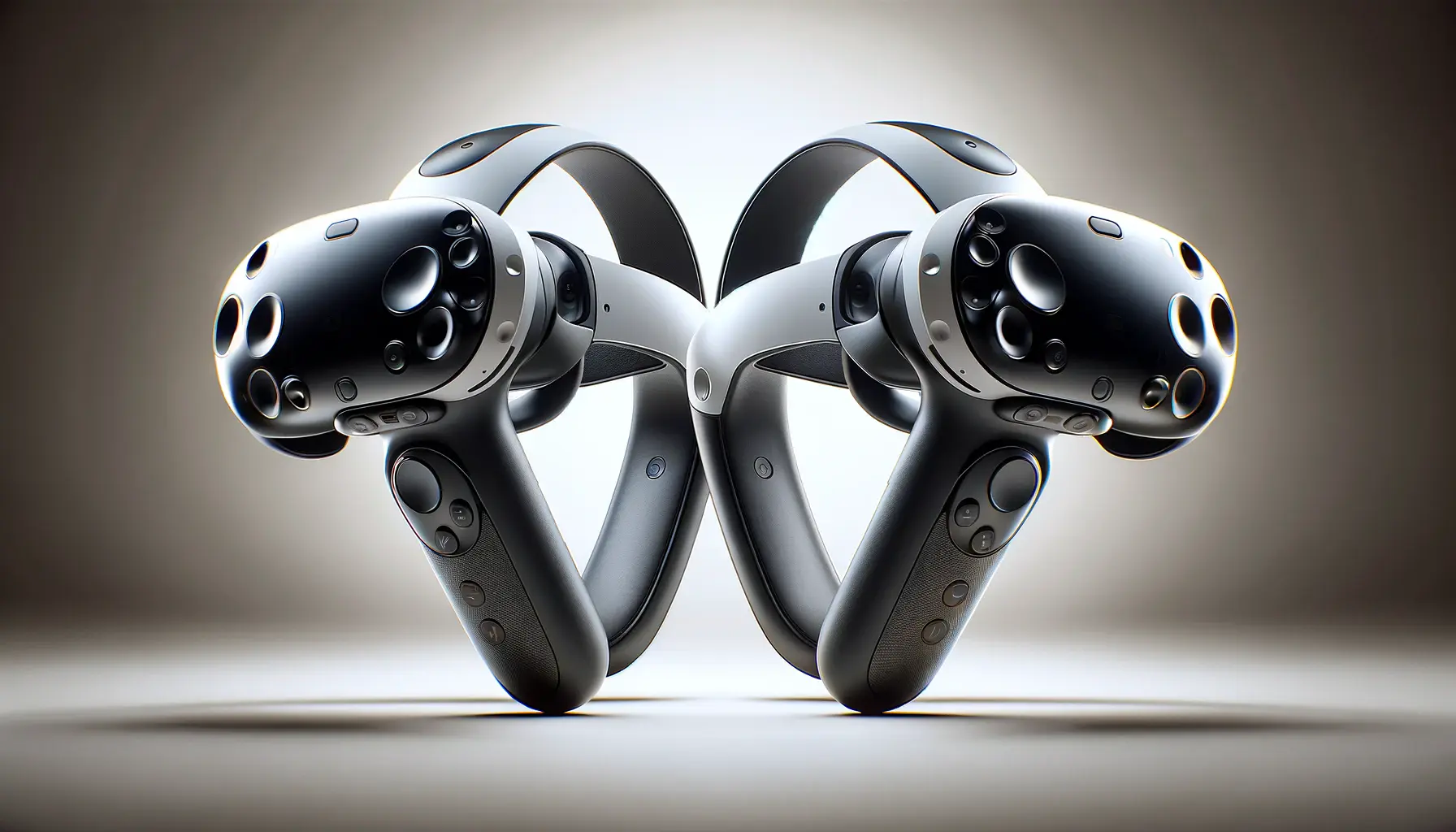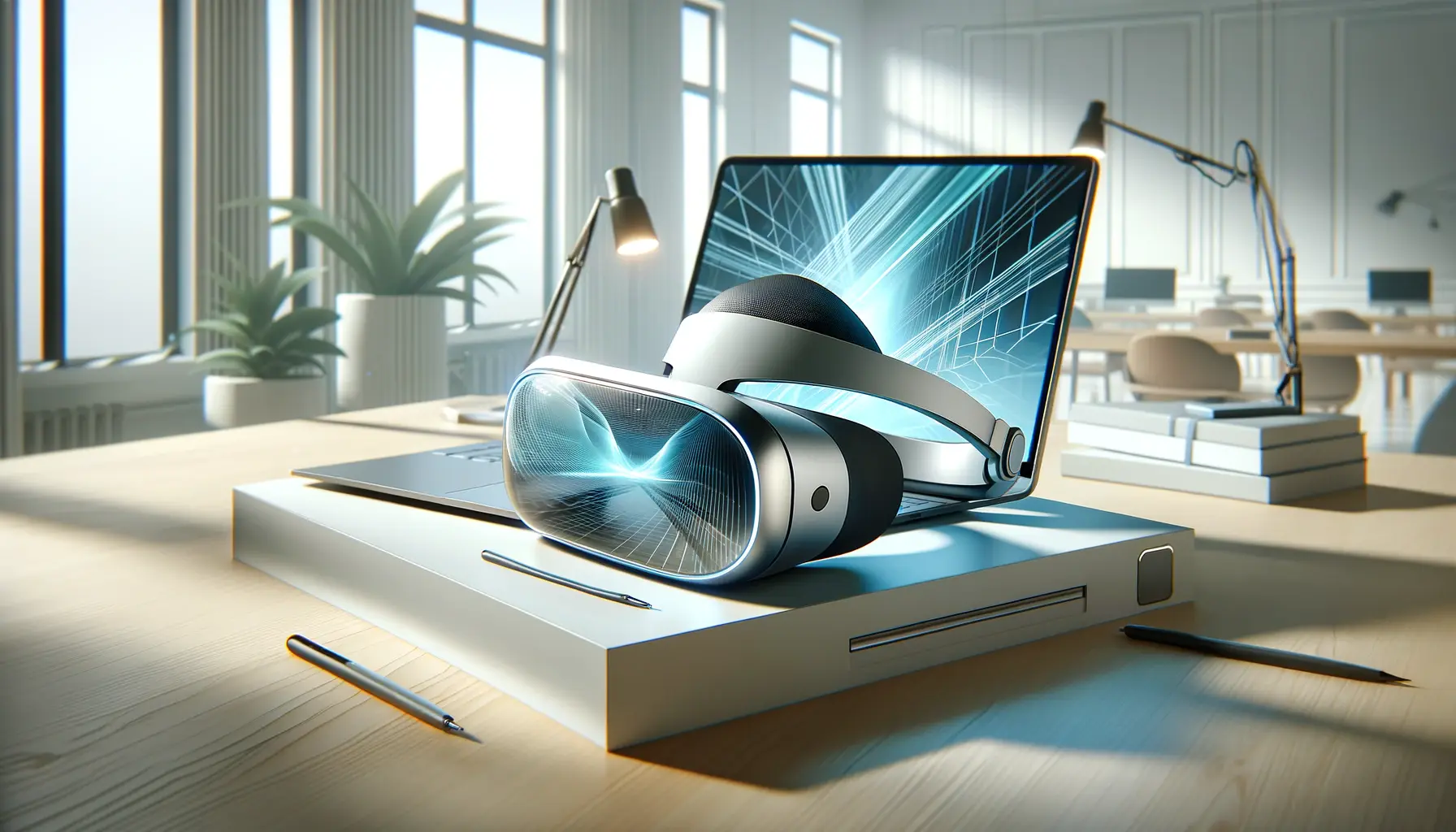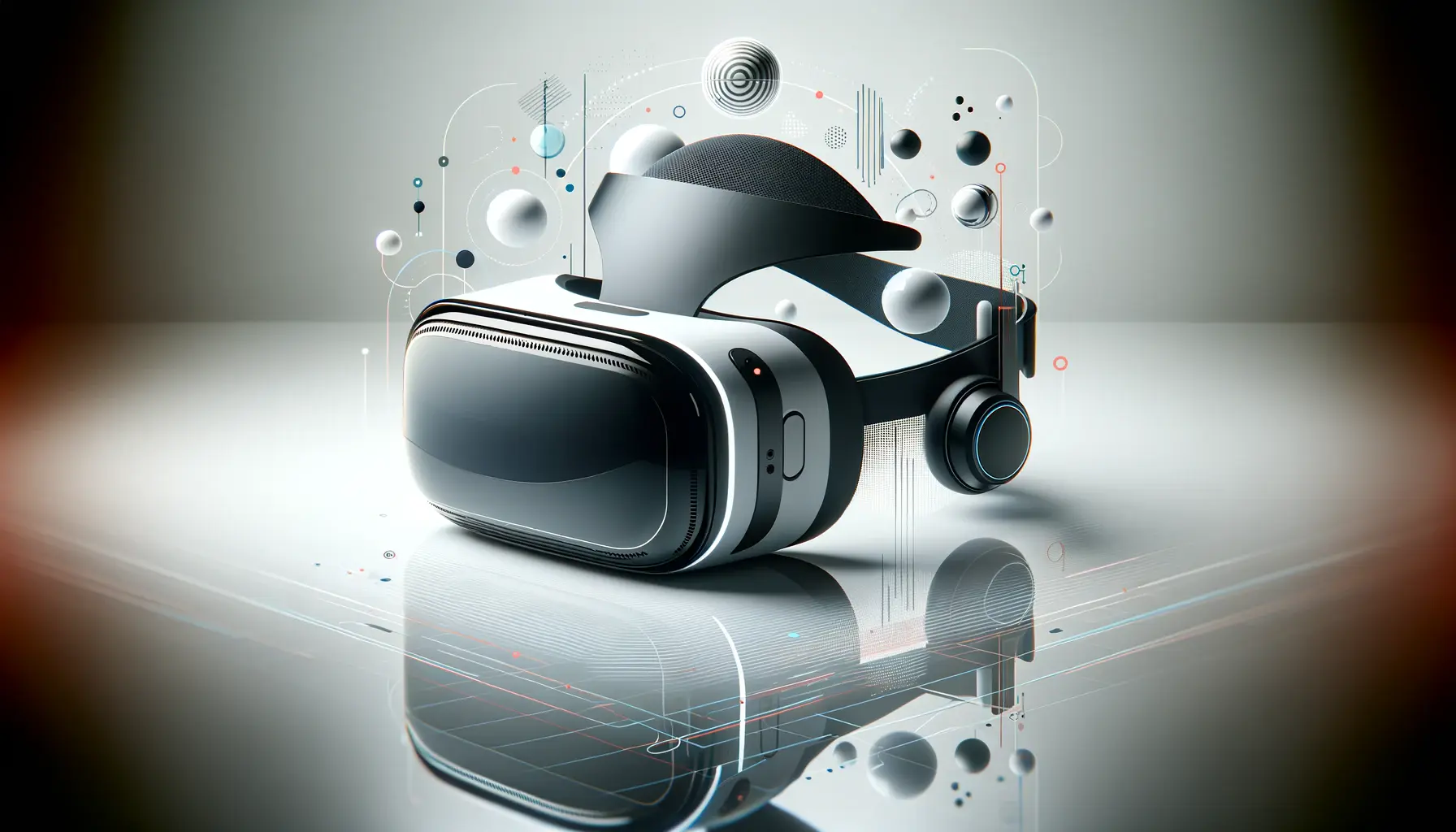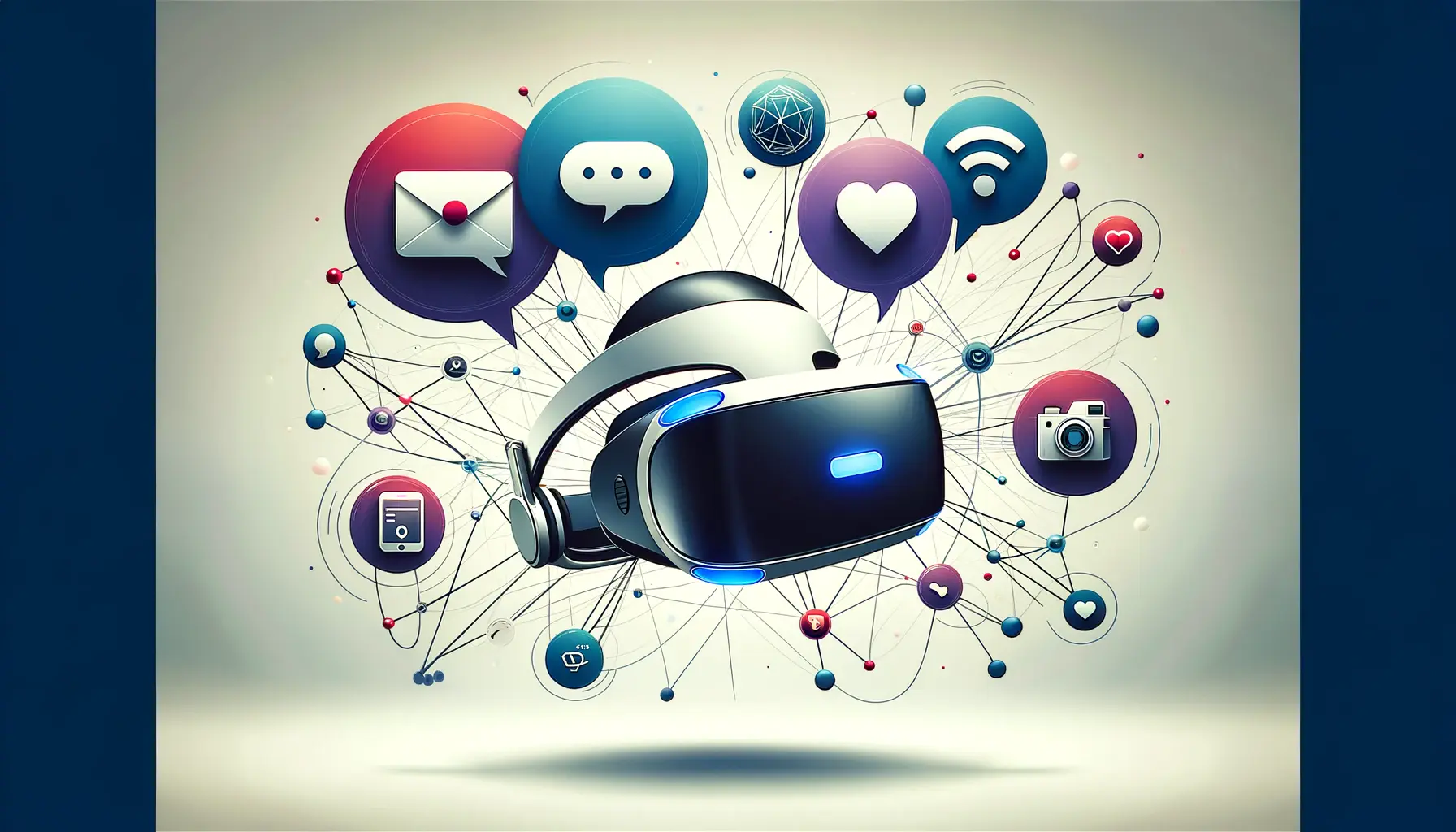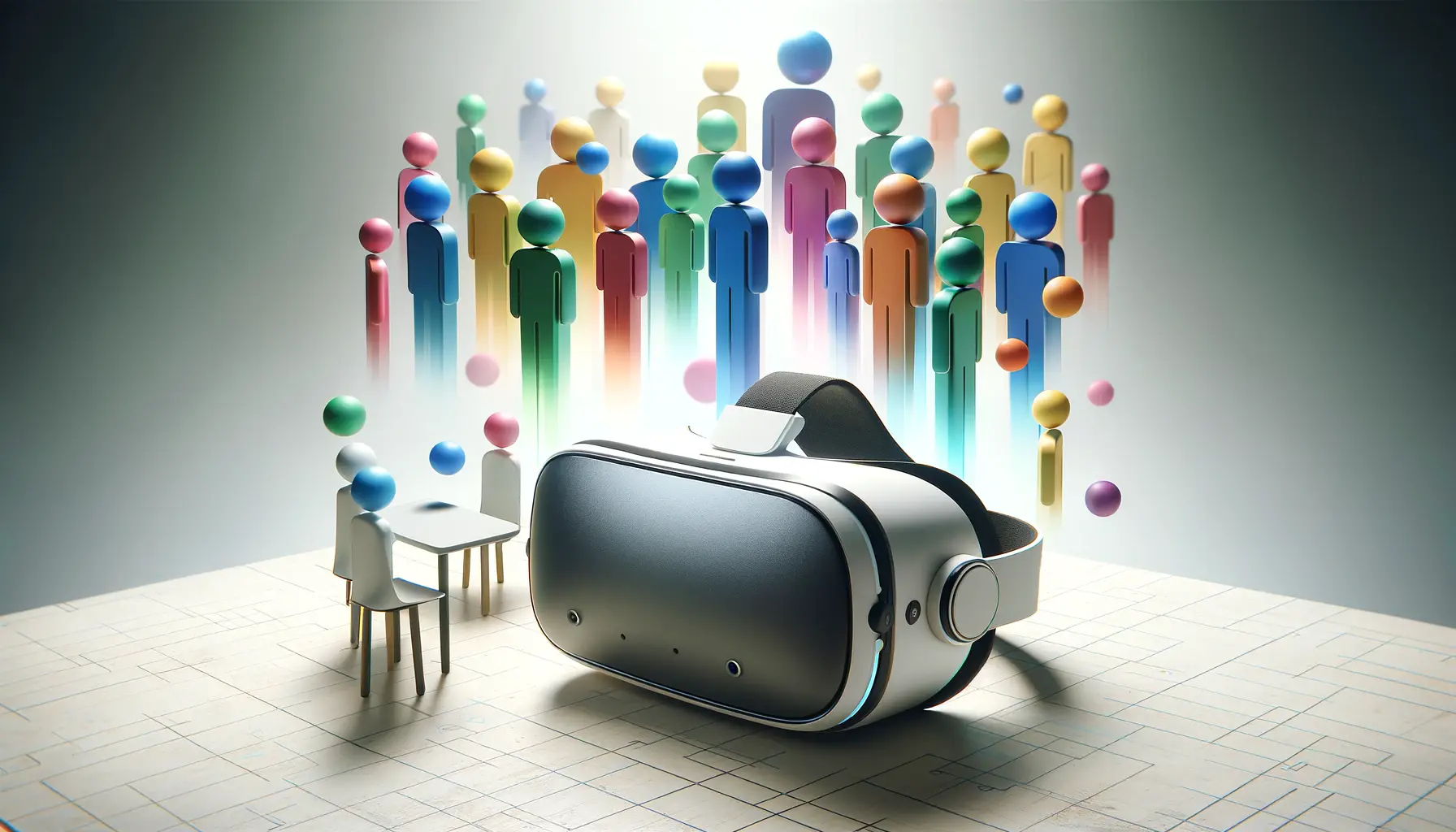The realm of virtual reality (VR) has been evolving at a breakneck pace, with Meta leading the charge into new frontiers.
The Meta Quest 3 stands as a testament to this rapid advancement, offering a glimpse into the future of immersive digital experiences.
This device not only pushes the boundaries of what’s possible in virtual reality but also introduces users to the untapped potential of mixed reality (MR), blending the digital and physical worlds in unprecedented ways.
As the latest iteration in Meta’s lineup of VR headsets, the Meta Quest 3 is designed to offer an unparalleled VR experience.
It builds on the successes of its predecessors, incorporating advanced technology to deliver improved performance, enhanced visuals, and more intuitive controls.
The Quest 3 is not just a gaming console; it’s a gateway to a myriad of virtual spaces, from interactive gaming environments and educational platforms to virtual workspaces and social hubs.
- Introduction to Meta Quest 3
- Design and Build Quality
- Performance and Hardware Specifications
- Software Ecosystem and User Interface
- Immersive Gaming and Entertainment Experiences
- Virtual Reality in Education and Training
- Future Prospects and Evolution of VR
- Embracing the Future with Meta Quest 3
- Meta Quest 3 Frequently Asked Questions
Introduction to Meta Quest 3
The Meta Quest 3 marks a significant leap forward in virtual reality technology.
With its sleek design and cutting-edge features, it aims to make VR more accessible and enjoyable for a broader audience.
The headset is equipped with a powerful Qualcomm Snapdragon XR2 Gen 2 processor, ensuring smooth performance across all applications.
Its high-resolution displays provide crystal-clear visuals, making every virtual environment more immersive and lifelike.
One of the most notable advancements in the Quest 3 is its mixed reality capabilities.
Through the use of external cameras and advanced sensor technology, the headset can seamlessly integrate virtual objects into the real world.
This opens up new possibilities for gaming, education, and productivity, allowing users to interact with virtual content in their physical space like never before.
Key Features and Enhancements
The Meta Quest 3 boasts several key features that set it apart from its predecessors and competitors.
These include:
- Improved Visual Fidelity: With a resolution of 2064 x 2208 pixels per eye, the Quest 3 offers stunning visual clarity, reducing the screen-door effect and making virtual worlds more realistic.
- Enhanced Performance: The Snapdragon XR2 Gen 2 chipset provides the computational power needed for complex VR applications, supporting more detailed environments and smoother gameplay.
- Mixed Reality Experiences: Advanced passthrough capabilities and spatial awareness allow users to bring virtual objects into their real-world environment, offering a new level of interaction and immersion.
- Controller Innovations: The new Touch Plus controllers feature improved ergonomics and precision tracking, making virtual interactions more natural and intuitive.
The Meta Quest 3 is not just an evolution in VR technology; it’s a revolution in how we interact with digital content, blurring the lines between the virtual and the real.
As we delve deeper into the capabilities and potential of the Meta Quest 3, it’s clear that this device is more than just a gaming headset.
It’s a comprehensive platform for exploring, creating, and connecting in the virtual realm.
Whether you’re a gamer, educator, professional, or simply a tech enthusiast, the Quest 3 offers something new and exciting to discover.
Design and Build Quality
The Meta Quest 3’s design is a harmonious blend of form and function, showcasing Meta’s commitment to creating a user-friendly and comfortable VR experience.
The headset’s exterior is sleek and modern, with an emphasis on lightweight materials that make extended wear more comfortable than ever before.
This design philosophy extends to every aspect of the Quest 3, from its adjustable straps to its balanced weight distribution, ensuring that users can immerse themselves in virtual worlds without the distraction of physical discomfort.
One of the standout features of the Quest 3’s design is its slim profile.
Thanks to the use of pancake lenses, the device is not only lighter but also significantly less bulky than its predecessors.
This reduction in size does not come at the expense of the user experience; instead, it enhances it by minimizing the physical barrier between the user and the virtual environment.
The result is a more immersive and natural VR experience that keeps users engaged for longer periods.
Material Quality and Comfort
The materials used in the construction of the Meta Quest 3 are of the highest quality, chosen for their durability and comfort.
The soft-touch fabric that covers the face interface feels gentle against the skin, reducing irritation during prolonged use.
Additionally, the breathable materials help to dissipate heat, preventing the lens from fogging and maintaining clear vision throughout the VR experience.
The adjustable head strap is another area where Meta has focused on comfort and customization.
It can be easily adjusted to fit a wide range of head sizes and shapes, ensuring a snug and secure fit for every user.
This attention to detail in the design and build quality of the Quest 3 demonstrates Meta’s understanding of the importance of comfort in creating an immersive VR experience.
Intuitive Controls and Accessibility
The Meta Quest 3’s controllers have been redesigned with ergonomics in mind, featuring a more intuitive layout that allows for natural hand movements and gestures.
The placement of buttons and triggers has been optimized to reduce strain on the fingers, making interactions within the virtual environment feel effortless.
Furthermore, the controllers are equipped with haptic feedback, providing tactile responses to virtual actions and enhancing the sense of presence within the game or application.
The thoughtful design and build quality of the Meta Quest 3 not only elevate the user experience but also reflect Meta’s vision for the future of virtual reality: a future where VR is accessible, comfortable, and immersive for everyone.
In conclusion, the Meta Quest 3’s design and build quality are a testament to Meta’s commitment to pushing the boundaries of VR technology.
By focusing on user comfort, intuitive controls, and a sleek, modern design, Meta has created a device that sets a new standard for what a VR headset can be.
Performance and Hardware Specifications
The Meta Quest 3 is not only a marvel of design but also a powerhouse of performance.
At the heart of this device is the Qualcomm Snapdragon XR2 Gen 2 platform, a processor specifically designed for VR and AR applications.
This chipset represents a significant upgrade over its predecessor, offering enhanced computational power, graphics performance, and energy efficiency.
These improvements are crucial for delivering the high-fidelity, immersive experiences that users expect from the latest generation of VR technology.
Alongside the advanced processor, the Quest 3 features a robust set of hardware specifications that push the boundaries of what’s possible in a standalone VR headset:
- Display: The Quest 3 boasts dual 2064 x 2208 pixel LCD panels, one for each eye, offering a combined resolution that significantly reduces the screen-door effect and enhances visual clarity.
- Refresh Rate: With support for 90-120Hz refresh rates, the Quest 3 ensures smooth motion and responsiveness, which is essential for reducing motion sickness and creating a more comfortable VR experience.
- Memory and Storage: Equipped with 8GB of RAM and options for 128GB or 512GB of internal storage, the Quest 3 can store a vast library of games and applications, all while ensuring smooth multitasking and quick load times.
- Audio: The integrated spatial audio system provides a 3D sound experience without the need for external headphones, making the audio experience more immersive and realistic.
- Battery Life: The Quest 3’s battery life is designed to last for several hours on a single charge, allowing for extended play sessions without the need for constant recharging.
Enhanced Connectivity and Sensors
The Quest 3 also features enhanced connectivity options, including Wi-Fi 6E support for faster and more reliable internet connections, and Bluetooth 5.2 for connecting external devices such as keyboards, mice, and game controllers.
These features make the Quest 3 a versatile device that can be used for a wide range of applications beyond gaming, including productivity and social networking.
In addition to its impressive connectivity options, the Quest 3 is equipped with an array of sensors that enable its mixed reality capabilities.
These include:
- Four wide-angle cameras for positional tracking and room-scale VR.
- Two RGB cameras for high-fidelity color passthrough and mixed reality experiences.
- A depth sensor for more accurate spatial awareness and object detection.
The combination of cutting-edge hardware, advanced connectivity, and sophisticated sensors makes the Meta Quest 3 a formidable device in the VR landscape, capable of delivering experiences that were previously unimaginable in a standalone headset.
The performance and hardware specifications of the Meta Quest 3 set a new benchmark for standalone VR devices.
With its powerful processor, high-resolution displays, and comprehensive sensor array, the Quest 3 is equipped to offer users a truly next-generation virtual reality experience.
Software Ecosystem and User Interface
The Meta Quest 3 is not just a triumph of hardware but also a showcase for Meta’s evolving software ecosystem.
The device runs on the Quest operating system, a custom Android-based platform designed specifically for VR.
This operating system provides a seamless and intuitive user interface, making it easy for users to navigate through menus, access content, and adjust settings without breaking immersion.
The Quest OS is also optimized for performance, ensuring that the system runs smoothly even when handling resource-intensive applications.
At the core of the Quest 3’s software experience is the Meta Quest Store, a comprehensive digital marketplace offering a wide range of VR content.
From blockbuster games and immersive educational experiences to fitness apps and social VR platforms, the Quest Store is designed to cater to a diverse array of interests and needs.
This diversity is crucial for attracting a broad user base and fostering a vibrant VR community.
Integration with Meta Services
One of the key advantages of the Quest 3 is its deep integration with Meta’s suite of services.
Users can easily connect with friends via Facebook, share VR experiences on Instagram, or collaborate with colleagues in Horizon Workrooms.
This integration extends the functionality of the Quest 3 beyond a traditional gaming console, transforming it into a versatile tool for social interaction, work, and creativity.
The device also supports cross-platform play and content sharing, allowing users to enjoy VR experiences with friends who may have different VR devices.
This openness is part of Meta’s broader strategy to build an interconnected VR ecosystem where users can interact and share experiences regardless of the hardware they own.
Developer Support and Content Creation
Meta has placed a strong emphasis on supporting developers and content creators, providing them with the tools and resources needed to create high-quality VR content.
The Quest Development Kit (QDK) offers a comprehensive set of APIs and libraries for building VR applications, while the Meta Quest Publishing program helps developers distribute and monetize their content on the Quest Store.
The Quest 3 also introduces new features designed to empower creators, such as improved hand tracking, voice commands, and the ability to create mixed reality content.
These features not only enhance the user experience but also open up new possibilities for developers to innovate and push the boundaries of VR.
The software ecosystem and user interface of the Meta Quest 3 are integral to its success, offering users a rich and diverse content library, seamless integration with Meta services, and robust support for developers and creators.
In conclusion, the Quest 3’s software ecosystem is a testament to Meta’s commitment to building a comprehensive and user-friendly VR platform.
With its intuitive interface, extensive content library, and deep integration with Meta services, the Quest 3 is poised to be a central hub for VR entertainment, social interaction, and productivity.
Immersive Gaming and Entertainment Experiences
The Meta Quest 3 elevates immersive gaming and entertainment to new heights, offering a library of content that spans genres and caters to all types of users.
From adrenaline-pumping action games and intricate puzzles to cinematic experiences and live concerts, the Quest 3 provides a portal to countless virtual worlds.
This diversity not only showcases the versatility of the device but also underscores Meta’s ambition to make VR a mainstream form of entertainment.
Key highlights of the Quest 3’s gaming and entertainment offerings include:
- Action-Packed VR Games: Titles like “Beat Saber” and “Superhot VR” offer intense, action-packed gameplay that takes full advantage of the Quest 3’s motion tracking and spatial audio for an exhilarating experience.
- Explorative Adventures: Games such as “Myst” and “The Room VR: A Dark Matter” transport players to other worlds, where they can solve puzzles and uncover mysteries in richly detailed environments.
- Social VR Experiences: Platforms like “VRChat” and “Rec Room” enable users to meet, interact, and play games with others from around the globe, fostering a sense of community and connection.
- Educational Content: Applications like “National Geographic Explore VR” and “Anne Frank House VR” offer immersive learning experiences, making history and science more engaging and accessible.
- Virtual Concerts and Events: The Quest 3 allows users to attend live concerts, performances, and events in VR, offering front-row seats to their favorite shows without leaving home.
Enhanced Immersion with Advanced Features
The Quest 3’s hardware and software advancements contribute significantly to the immersion of its gaming and entertainment experiences.
Features such as high-resolution displays and spatial audio create a sense of presence, making virtual environments feel real.
Additionally, the improved hand tracking and haptic feedback in the controllers allow for more natural and intuitive interactions, further enhancing the sense of immersion.
Developers are leveraging these features to create content that is not only visually stunning and engaging but also innovative in its use of VR technology.
For instance, games that incorporate mixed reality elements blur the line between the virtual and the real, offering experiences that are unique to VR.
The immersive gaming and entertainment experiences available on the Meta Quest 3 highlight the device’s potential to redefine how we play, learn, and connect with content and each other in virtual spaces.
In conclusion, the Meta Quest 3 stands as a beacon for the future of immersive gaming and entertainment.
With its extensive content library, advanced features, and commitment to innovation, the Quest 3 is not just a gaming console but a comprehensive platform for virtual experiences that engage, educate, and entertain.
Virtual Reality in Education and Training
The Meta Quest 3 is pioneering new frontiers in education and training, harnessing the power of virtual reality to transform how knowledge is imparted and skills are acquired.
VR’s immersive nature offers a unique learning environment that can enhance understanding, retention, and engagement.
The Quest 3, with its advanced features and capabilities, is at the forefront of this educational revolution, providing tools and platforms that cater to a wide range of learning objectives and styles.
Key applications of the Quest 3 in education and training include:
- Immersive Learning Modules: Subjects like history, science, and art come alive in VR, allowing students to explore ancient civilizations, dissect virtual frogs, or walk through famous museums, making learning an engaging and interactive experience.
- Professional Skills Development: VR simulations on the Quest 3 offer hands-on training for professionals in fields such as medicine, aviation, and engineering, where learners can practice procedures and techniques in a risk-free, virtual environment.
- Language Learning: Language acquisition apps utilize VR’s immersive capabilities to place learners in real-world scenarios where they can practice speaking and listening in a new language, enhancing fluency and comprehension.
- Soft Skills Training: VR experiences designed to develop communication, leadership, and teamwork skills immerse users in scenarios that require negotiation, problem-solving, and collaboration, providing valuable practice in a controlled setting.
Enhancing Accessibility and Inclusivity
One of the most significant benefits of using the Quest 3 in education and training is its ability to make learning more accessible and inclusive.
VR can bridge geographical and physical barriers, providing high-quality educational content to learners regardless of their location or mobility.
Additionally, VR can be tailored to accommodate different learning styles and needs, including visual and kinesthetic learners, ensuring that everyone has the opportunity to benefit from immersive learning experiences.
The Quest 3 also supports collaborative learning environments, where students can work together in virtual spaces, fostering a sense of community and teamwork.
These collaborative experiences are particularly valuable in remote learning scenarios, helping to reduce feelings of isolation and disconnection.
The application of the Meta Quest 3 in education and training demonstrates VR’s potential to revolutionize learning and skill development.
By providing immersive, interactive, and accessible learning experiences, the Quest 3 is helping to shape the future of education.
In conclusion, the Meta Quest 3’s impact on education and training is profound, offering innovative solutions to traditional learning challenges.
As VR technology continues to evolve, the Quest 3 remains at the cutting edge, driving forward the integration of virtual reality in educational contexts and paving the way for a future where learning is limitless, engaging, and accessible to all.
Future Prospects and Evolution of VR
The Meta Quest 3 represents a significant milestone in the evolution of virtual reality, showcasing the immense potential of VR technology to transform our digital interactions.
However, the journey of VR is far from complete.
The future of virtual reality, propelled by devices like the Quest 3, promises even more groundbreaking advancements that will further blur the lines between the digital and physical worlds.
As we look ahead, several key areas are poised to shape the next generation of VR experiences.
Anticipated advancements in VR technology include:
- Increased Realism: Future VR devices will likely feature even higher resolution displays, more accurate motion tracking, and advanced haptic feedback systems, making virtual environments indistinguishable from the real world.
- Enhanced Portability and Comfort: The evolution of VR hardware will focus on making devices lighter, more comfortable, and wireless, enabling longer usage periods without discomfort or the need for external power sources.
- Greater Interoperability: As the VR ecosystem matures, we can expect a more interconnected experience, with seamless integration between different VR platforms, devices, and even augmented reality (AR) systems.
- Expanded Content Libraries: The future will bring a diversification of VR content, extending beyond gaming and entertainment to include more educational, social, and professional applications.
Impact on Society and Industry
The continued evolution of VR, led by innovations like the Meta Quest 3, will have profound implications for society and various industries.
In education, VR can democratize access to high-quality learning resources, making experiential learning available to students worldwide.
In healthcare, VR simulations can revolutionize medical training and patient care, offering new ways to diagnose, treat, and rehabilitate.
The entertainment industry will also see a transformation, with VR providing immersive experiences that redefine storytelling and audience engagement.
Moreover, the workplace is set to evolve with VR, enabling remote collaboration and virtual workspaces that mimic physical offices.
This could lead to a more flexible and efficient global workforce, breaking down geographical barriers and fostering a more inclusive work environment.
The future of virtual reality, heralded by the Meta Quest 3, is bright, with endless possibilities for innovation, immersion, and connectivity.
As VR technology continues to advance, it will undoubtedly play a pivotal role in shaping our digital future, offering experiences that are currently beyond our imagination.
In conclusion, the Meta Quest 3 is just the beginning of a new era in virtual reality.
Its impact extends beyond the realm of entertainment, hinting at a future where VR changes how we learn, work, and connect with each other.
As we stand on the brink of this exciting frontier, the potential of VR to revolutionize our digital lives has never been clearer.
Embracing the Future with Meta Quest 3
The journey through the capabilities, design, and potential of the Meta Quest 3 has illuminated not just the advancements in virtual reality technology but also the broader implications for society, education, and various industries.
As we stand on the precipice of a new era in digital interaction, the Quest 3 emerges as a beacon of innovation, pushing the boundaries of what is possible in immersive experiences.
This conclusion aims to encapsulate the essence of the Meta Quest 3 and its role in shaping the future of virtual reality.
The Pinnacle of VR Innovation
The Meta Quest 3 represents the culmination of years of research, development, and user feedback, embodying the pinnacle of VR innovation.
Its advanced hardware, user-centric design, and expansive software ecosystem set a new standard for what consumers can expect from a VR device.
The Quest 3 is not just a tool for gaming and entertainment but a versatile platform that offers:
- Unparalleled immersive experiences in gaming and entertainment.
- Innovative applications in education and professional training.
- New avenues for social interaction and collaboration.
These features underscore the Quest 3’s potential to revolutionize how we interact with digital content, making virtual experiences more accessible, engaging, and meaningful.
Charting the Course for VR’s Future
The impact of the Meta Quest 3 extends beyond its technical specifications and content library.
It serves as a harbinger for the future of VR, indicating the direction in which the technology is headed.
The Quest 3’s emphasis on mixed reality, portability, and social connectivity points towards a future where VR is seamlessly integrated into our daily lives, offering:
- More realistic and immersive virtual environments.
- Greater accessibility and ease of use for a wider audience.
- Enhanced opportunities for remote learning, work, and play.
As VR technology continues to evolve, devices like the Quest 3 will play a crucial role in defining the landscape of digital interaction, blurring the lines between the virtual and the real.
A Catalyst for Change
The Meta Quest 3 is more than just a piece of technology; it is a catalyst for change.
By democratizing access to high-quality VR experiences, the Quest 3 has the potential to transform education, healthcare, entertainment, and the workplace.
It challenges us to reimagine the possibilities of digital technology and its capacity to enrich our lives.
As we look to the future, the Quest 3 invites us to explore, learn, and connect in ways we never thought possible, marking the beginning of a new chapter in the story of virtual reality.
In conclusion, the Meta Quest 3 stands as a testament to the progress and potential of virtual reality.
Its development reflects a deep understanding of user needs and a commitment to pushing the envelope of technological innovation.
As we embrace the future with the Quest 3, we open ourselves to a world of possibilities, where virtual reality enriches every aspect of our digital lives, making the once-impossible a tangible part of our everyday reality.
Meta Quest 3 Frequently Asked Questions
Explore the most common inquiries about the Meta Quest 3 to enhance your understanding and experience with this cutting-edge VR headset.
The Meta Quest 3 offers several hours of battery life on a single charge, allowing for extended gaming, learning, or social experiences.
Yes, the Meta Quest 3 is ideal for professional training, offering VR simulations for various industries such as healthcare, aviation, and engineering.
Yes, the Meta Quest 3 supports multiplayer games, allowing users to connect and play with friends and family in immersive VR environments.
Yes, the Meta Quest 3 is compatible with PC VR games through the Quest Link and Air Link, offering access to a vast library of VR content.
The Meta Quest 3 integrates seamlessly with social media, enabling users to connect with friends, share experiences, and attend virtual events together.
Key features include high-resolution displays, advanced motion tracking, mixed reality capabilities, and a vast content library across genres.
Yes, the Meta Quest 3 offers immersive educational content, making learning more engaging and accessible for students of all ages.
The Meta Quest 3 features significant upgrades in performance, visual fidelity, and user experience, setting a new standard in standalone VR technology.





